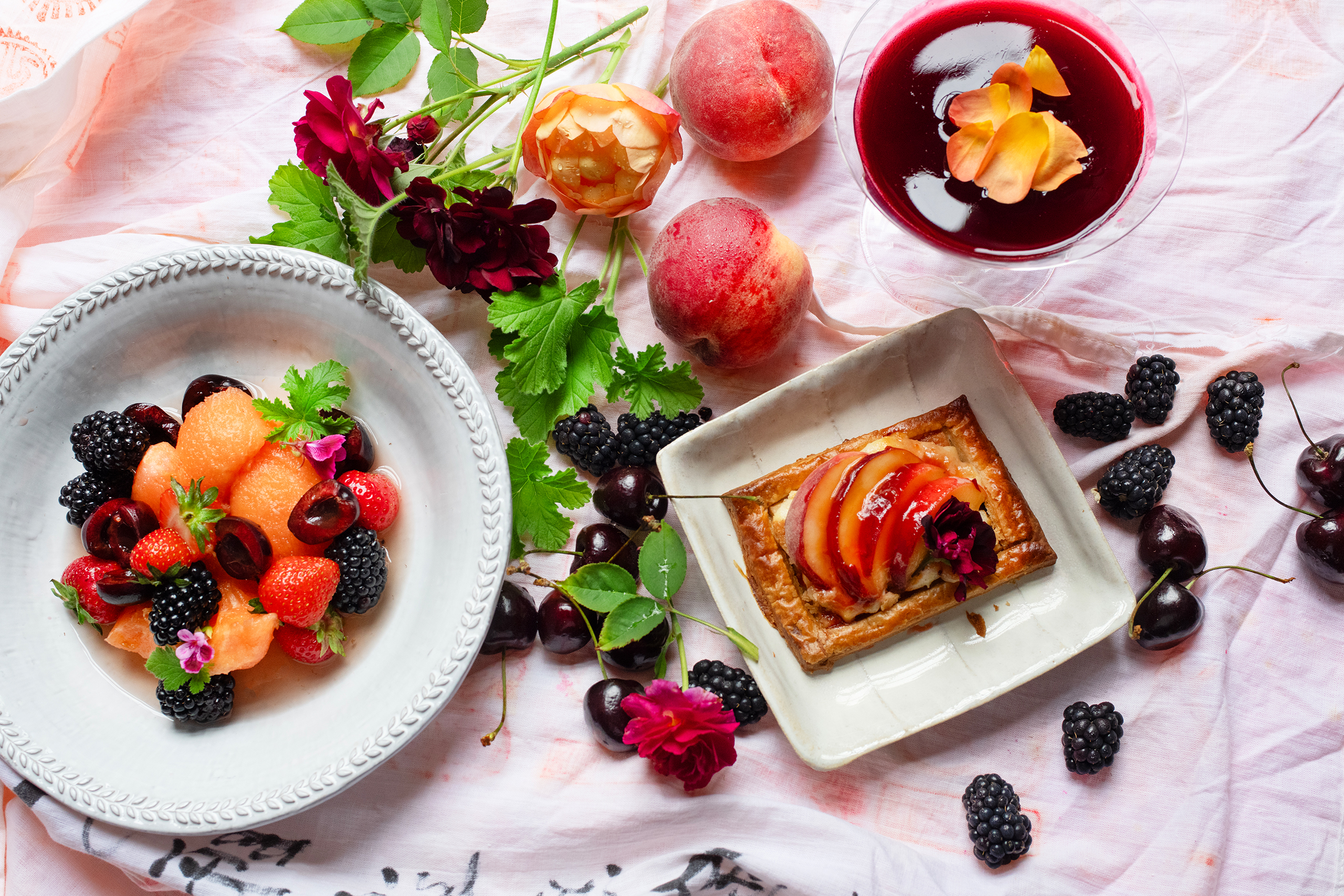Photographs by Jonathan Lovekin
As a long summer lunch draws to a close, a dessert is called for. It would be a missed opportunity not to offer something made with the season’s berries and stone fruits, the bounty we have at this time of year.
It could be as simple as a bowl of berries, perhaps in assorted shades of crimson – raspberries, loganberries or mulberries – or blackberries, or perhaps the berries piled on a crisp cushion of meringue.
To show the flavours at their most intense, I often leave dairy out of the equation, allowing the fruits to sit with scented syrups, on a raft of buttery pastry or as a glistening jelly or granita.
The cherry season has been extraordinary this summer. I have feasted on them like never before. There are still plenty of the dark, sweet orbs around and I like to marry them with berries and apricot-fleshed melon in a flower syrup. I chose rose-scented geraniums this year – officially known as pelargoniums – to flavour my sugar syrups. You can also use lemon-scented leaves, but I suggest you avoid the camphor varieties, which aren’t suitable for kitchen use.
There are two ways of making a floral syrup. You can steep the lightly crushed leaves in a warm mixture of sugar and water to extract their essential oils, or you can make a geranium sugar by letting a few leaves sit in a bag or glass jar of granules for a day or two. The sugar, now infused with the soft notes of rose or lemon, can then be used to make a syrup.
Good though many artisan-made ice-creams and sorbets are, it is simple enough to make your own. Most of them require nothing more than fruit, cream or yoghurt and a little sugar, but the texture will be improved greatly by using an ice-cream machine.
Fine ices can be made without a machine, just make sure to check them every hour, whisking the frozen edges into the liquid centre, until the mixture is almost set. Fruit-flavoured ices tend to lose intensity after a few days in the freezer, so are best eaten as soon as possible after making.
I often bring out these fruit recipes for tea instead of dessert. A late-summer afternoon tea, situated in the shade of a tree’s ample canopy, is the perfect occasion for pastries filled with custard or frangipane or cream cheese, their surface adorned with berries and fruit jelly.
There is barely a dessert I make at this time of year that doesn’t seem to glisten with fruit or its juice. A jelly, a sorbet, a fruit salad. Something sweet for lunch or for afternoon tea with which to quietly celebrate the summer.
Blackcurrant jelly
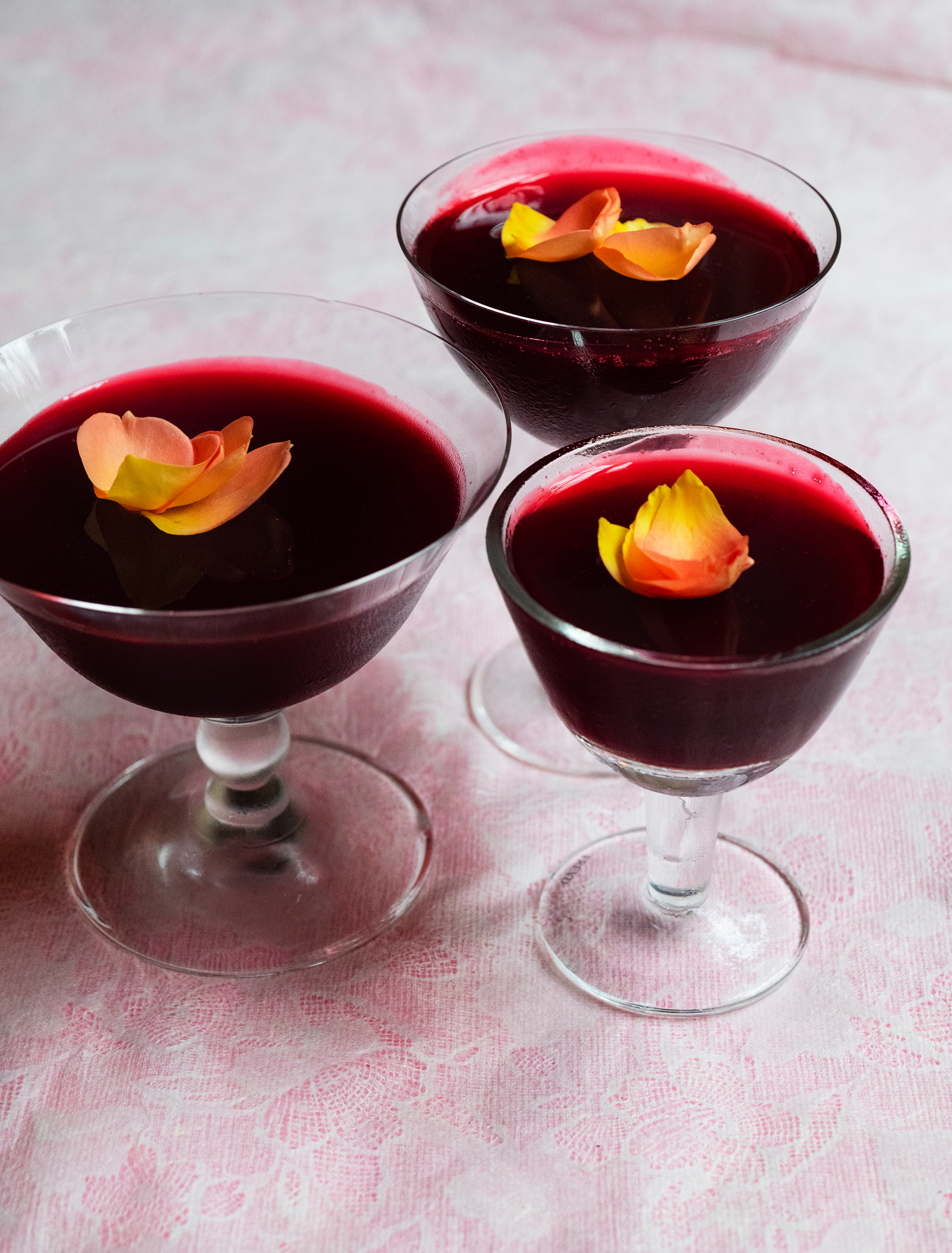
A bright, tart and flavoursome jelly, seasoned with nostalgia for anyone brought up, as I was, on blackcurrant cordial. Frozen blackcurrants work perfectly here.
Serves 4
blackcurrants 250g
water 500ml
caster sugar 80g
gelatine 3 small sheets
edible petals to decorate (optional)
creme fraiche 100g, to serve
Remove the stems from the blackcurrants and put the fruit in a stainless steel saucepan. Pour in the water, add the sugar and bring to the boil. Soak the sheets of gelatine in a bowl of cold water.
Once the blackcurrants have started to burst and the liquid has become a deep purple syrup, pour them into a sieve over a jug and let them drip for 5 minutes. Lift the softened gelatine from the water and drop into the hot syrup, stirring until it has dissolved.
Pour the syrup into 4 small dishes or glasses (it looks particularly good in the latter) and leave to set in the fridge for 4 hours. The jelly is ready when it quivers lightly when shaken. The longer it spends in the fridge, the firmer it will become.
Should you wish, decorate the jellies with a few edible petals and offer a little creme fraiche to go with them.
Summer fruits with geranium syrup
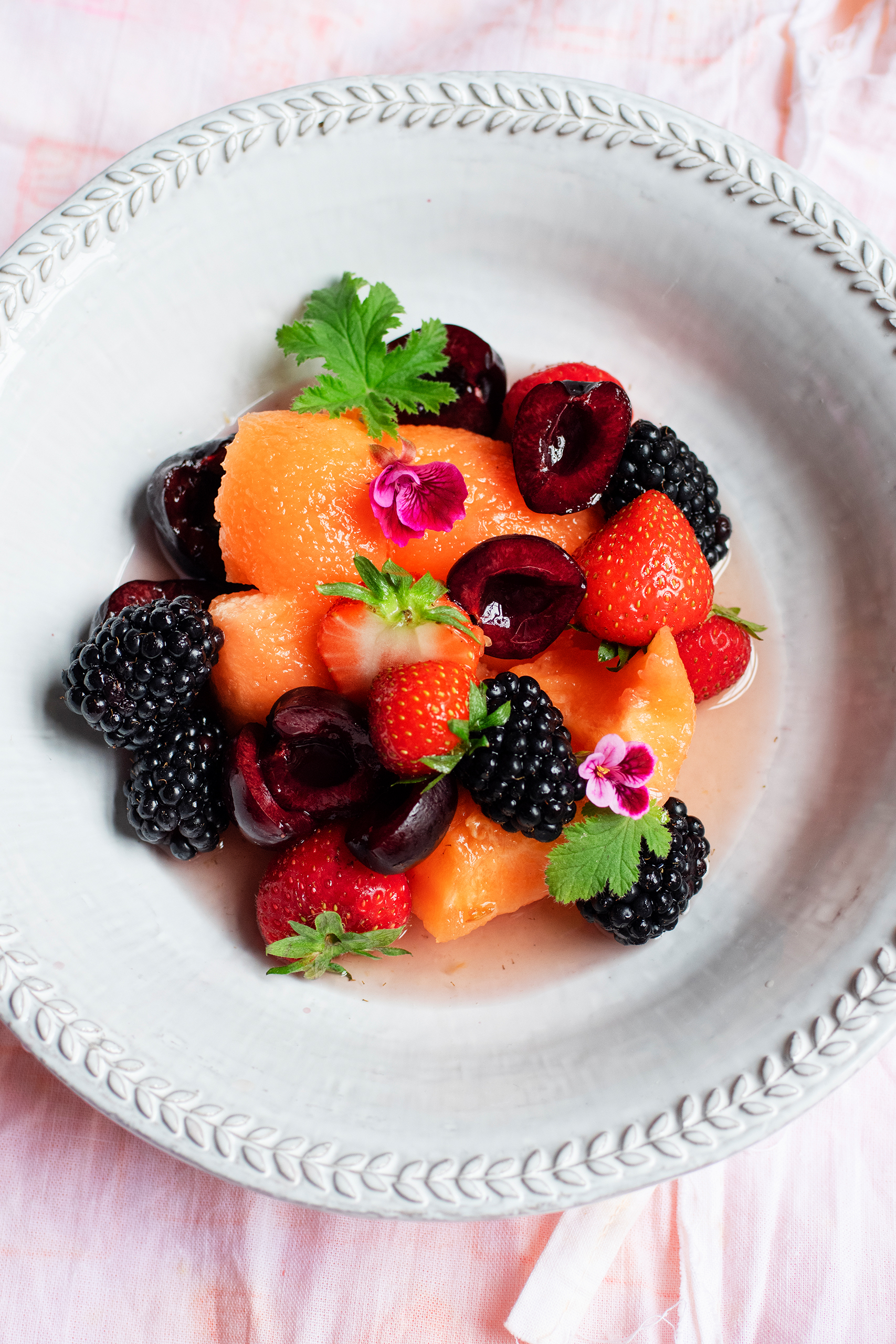
Summer fruits in a delicate, lightly floral syrup. An elegant and sweetly perfumed way to end a long summer lunch, this is most refreshing when eaten thoroughly chilled. I have used blackberries, strawberries, deep red cherries and ripe melon, though loganberries and raspberries would be good too. I say scented geranium because that is how most of us know them. Botanically, they are scented pelargoniums.
Serves 4
strawberries 16
blackberries 12
cherries 12
cantaloupe ½
For the syrup
caster sugar 100g
water 200ml
vanilla pod 1
scented geranium leaves 6
To make the syrup, put the sugar and water in a small saucepan. Split the vanilla pod in half lengthways to reveal the seeds, and drop into the pan. Bring the liquid to the boil, then lower the heat and simmer for a minute or two until the sugar has dissolved. Remove the pan from the heat and set aside to cool.
Once cooled, remove the vanilla pod and pour the syrup into a bowl. Lightly crush the scented geranium leaves in your hand (this will release their essential oils) and push them down into the syrup. Leave it in the fridge to chill thoroughly.
Cut the strawberries in half and put them in a serving bowl along with the blackberries. Halve the cherries, discarding their stones, then add them to the bowl. Take 4 scoops of flesh from the cantaloupe (an ice-cream scoop is ideal) and add them to the fruits.
Remove and discard the leaves from the syrup, then pour it over the fruits. Leave to chill for 20 minutes before serving.
Raspberry granita
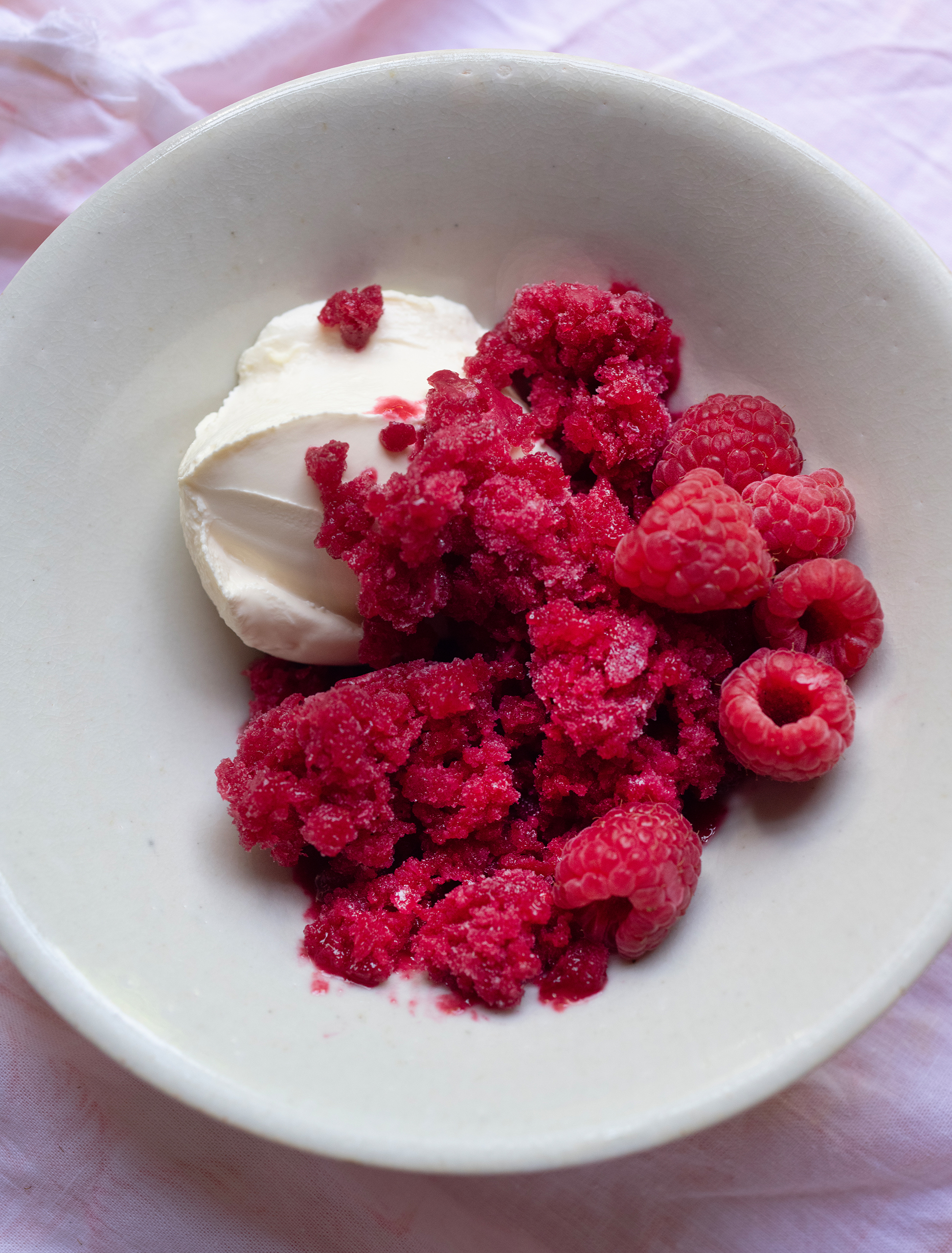
A cross between a sorbet and a Japanese kakigōri (shaved ice). I make this raspberry one the most often, but black- or redcurrants in place of the berries are refreshing too. If you’re using redcurrants, elderflower is the cordial to use.
Serves 4
water 200ml
sugar 100g
raspberries 500g, plus extra to serve
blackcurrant cordial 120ml
creme fraiche to serve (optional)
Put the water and sugar into a small pan and bring to the boil. Remove from the heat as soon as the sugar has dissolved and allow to cool. Check the raspberries, discarding any that are not at their best. Put the fruit in a blender or food processor and reduce to a puree. Push the puree through a sieve into a bowl to remove the seeds. This will take a few minutes, pushing it through with the back of a spoon, but is well worth it. Remember to scrape all the puree from the underside of the sieve.
Stir the cordial and the cooled syrup into the bowl of raspberry puree, then pour into a freezer container. Cover tightly with a lid and freeze for about an hour and a half. Check the granita’s progress regularly, stirring the freezing edges into the middle.
Continue freezing and stirring in the edges every hour or so until the mixture is frozen solid. Draw the tines of a fork through the granita to produce furrows of ice crystals. It will keep like this in the freezer for a day or two. Serve with creme fraiche and extra raspberries, if you like.
Peach and cream cheese tarts
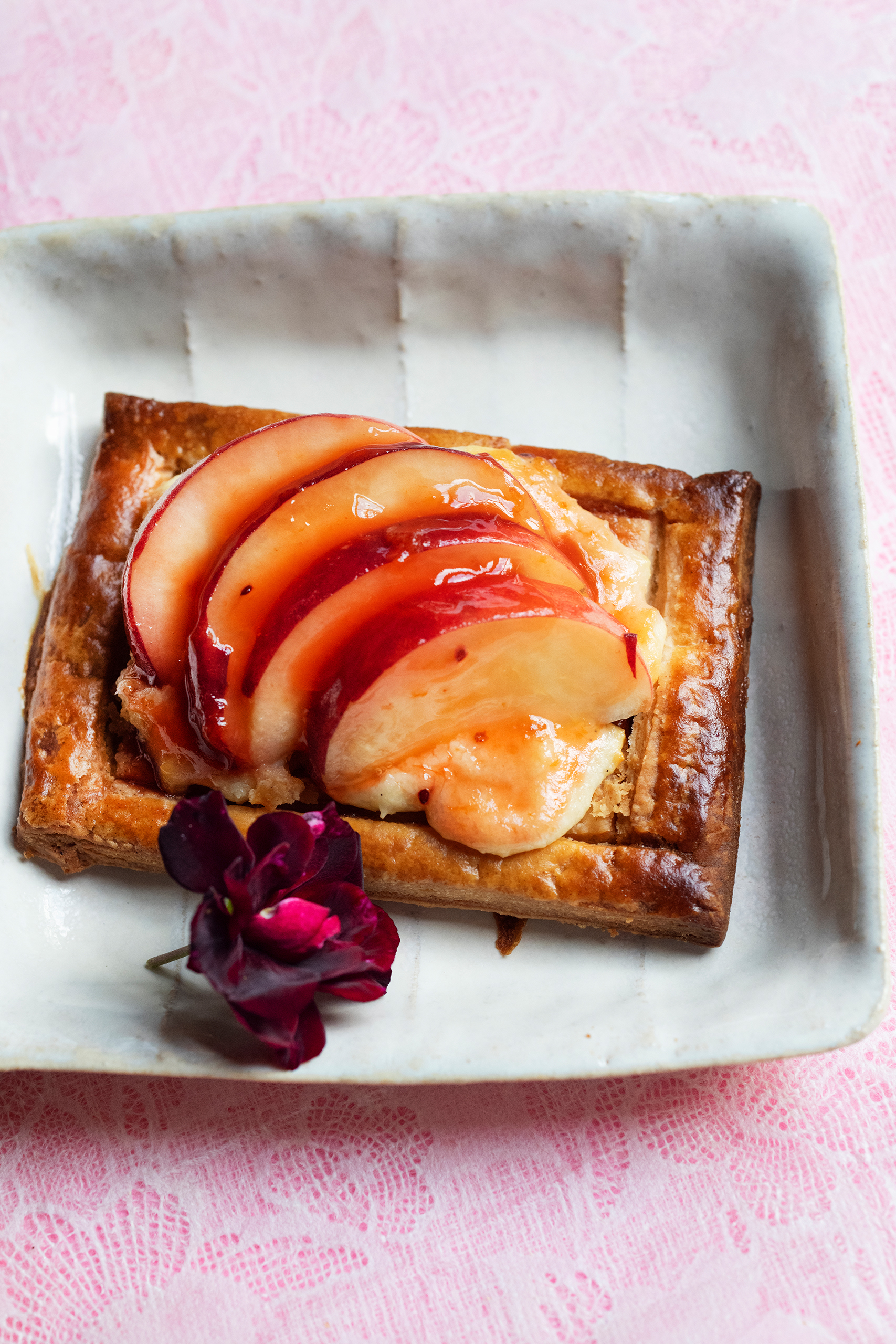
Crisp pastry and sweet, luscious peaches – these work well as a dessert or for tea. You could use prepared puff pastry if you wish to save time but I do think making your own rough puff pastry is worth it in this instance. The marriage of crumbly, buttery pastry, almond-scented cream cheese and ripe peaches is one of summer’s best.
Makes 6
full-fat cream cheese 200g
ground almonds 50g
vanilla extract 1 tsp
caster sugar 1 tbsp
ripe peaches 6, each cut into 6 segments, stones removed
fruit jelly (apple, apricot or medlar) 4 tbsp
For the pastry
plain flour 200g
butter 150g, chilled
salt ½ tsp
water 50ml, ice cold
egg 1, lightly beaten
You will need a large baking sheet. First make the pastry. Put the flour into the bowl of a food mixer fitted with a flat, paddle attachment. Chop the butter, then add it to the flour, mixing briefly until you have crumbs of differing sizes. (It is crucial that you don’t take it to a fine crumb here – you need to still be able to see lumps of butter in the flour.)
Stir in the salt and water and mix briefly to bring it to a firm, ragged dough. Tip the dough on to a floured board, then press in a thick, squarish block, wrap in greaseproof paper and rest it in the fridge for 30 minutes.
Roll the dough into a long rectangle, about 15cm x 40cm. Fold the bottom third up and the top third down over it, as if you were folding a letter.
Turn the dough one quarter turn clockwise, then repeat the rolling and folding. If you have time, rest the dough again for an hour. (It won’t be a disaster if you don’t, but I feel the extra resting does give it a flakier finish.)
Roll out the pastry into a rectangle, about 30cm x 20cm. Cut into 6 equal rectangles, then place them, with space between, on a baking sheet.
Using the tip of a sharp knife, score a smaller rectangle 1cm in from the edges of each piece. Leave in the fridge to chill for 30 minutes.
To make the filling, put the cream cheese into a mixing bowl, then add the ground almonds, vanilla extract and sugar, and stir until combined. Set the oven at 210C fan/gas mark 8 and put a baking sheet on the middle rack. (If you place your sheet of pastries on top of this, they will develop a crisper base.)
Brush the outside rim of each pastry rectangle with a little of the beaten egg, taking care not to let it drip down the edges (which would stop the pastry rising). Bake the chilled pastries for 15 minutes, or until pale gold.
Remove the partly baked pastries from the oven. Create a slight hollow in the centre of each one by pressing down the inner scored square with the back of a teaspoon. Fill the hollows with the cream cheese mixture, then return the pastries to the oven and bake for a further 10 minutes, until the surface of the filling is just set.
Remove the pastries from the oven and top each one with an even number of the peach slices, pressing them gently into the cream cheese filling.
Melt the fruit jelly in a small saucepan, then brush it over the top of the pastries and peaches. Leave to cool. These are best enjoyed on the same day.
